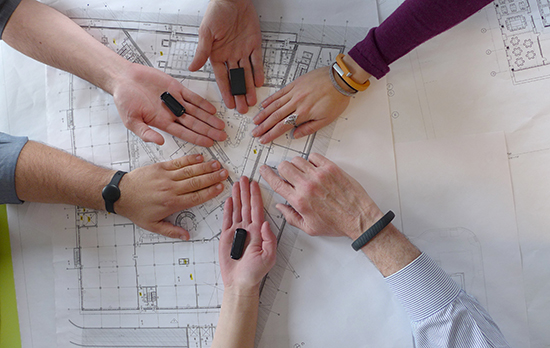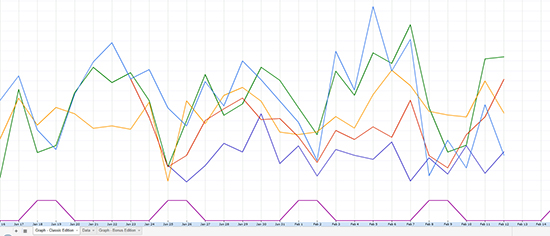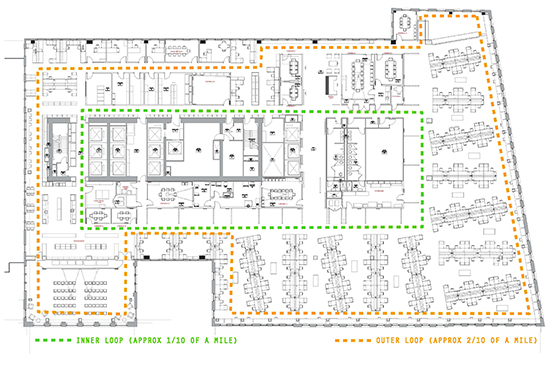
Photo: Kerry Drake, PAYETTE
Since about the beginning of 2014, a few of us have decided to embark on an informal and judgment-free experiment by documenting our team’s daily stepping habits (rain, sleet or snow) in an effort to increase our levels of activity. It’s been interesting to compare how different, and sometimes similar, our stepping habits have been. In particular we’ve noticed the Sunday Slide, which seems to be the day when everyone’s step count takes a little bit of a dip for the worse. On other days, some numbers seem to skyrocket, giving avid steppers a chance at glory for, at least, as long as they can hold onto the lead, or fly to California. Hal explains his theory on the cause for stepping fluctuations with this observation: “Other trends, along with the Sunday Slide may include the Monday Panic when step counts increase due to weekend BaseCamp activity; i.e. panic resulting in rapid movement “…they requested what?!!” Or Midweek ping-pong, which results in spastic increases in the step count of some members.”
The 10,000 Step Challenge is recommended by many as a daily guideline for how much walking adults should be fitting into their daily lives (which equates to approximately 5 miles a day).

Using Google Docs, Matthew Fickett created a simple spreadsheet which allows our stepping totals to be tracked in graph form. The graph is based on the honor system, of which, for the most part, seems to be working. We are currently exploring other web-based ways to chart our collective steps.
Here’s what the team has to say about how they like their own personal fitness trackers, and what they hope to achieve by using them:
Jawbone UP:
Elen
“I went with the Jawbone Up for two reasons, the cool graphs and the various color options for the band (yes, I do judge my tracking devices by their cover).Having the ability to get data on how much I walk and comparing it with teammates has made me take some extra measures in upping my active time that I would not have considered otherwise.Whether it is a walk to the kitchen instead of the kitchenette in the office, walking home from a yoga studio (in the cold) or making circles around my living room to make sure I hit that 10,000 steps, it is all primarily motivated by the thought of the first question of every workday morning ‘did you upload your numbers?’ ”
Hal
“I think my favorite thing about my Jawbone UP is the ability to track sleep. It has shown me that I fall asleep in about 15 minutes, not the hours I swore it took; and that I wake up only 2 or 3 times a night not the dozen or so times that I truly believed – I still question it’s accuracy. Most importantly it has illuminated how my energy, memory and sense of wellbeing are connected to my diet, sleep and activity level. I suppose this connection is obvious to most, I guess I was napping in the back of the class after skipping gym and enjoying my Doritos on the day that was covered.”
FItBit One:
Matthew
“Seeing the data on how active I am is very illuminating. It’s shown me that there’s a strong correlation between how much I walk and how I feel at the end of the day. Those days where I get home feeling sluggish and tired, but can’t sleep? I didn’t move all day. The 20,000 step days? I feel great. Being able to see this in the data reminds me to make choices to be active during the day. Then there’s the competition (I mean, judgment-free support). When it’s nine degrees in a polar vortex I might be tempted to take the T to work, but I know Liz has been up doing home improvement since before I went to bed last night, and she can see my step numbers. What are a few icicles in my beard compared to falling behind? I just put my FitBit in my pocket and get started.”
Liz
“I think it’s just downright unfair that Matt walks 3 miles to work. I mean, come on, who does that? If it weren’t for him I might just have a chance to win this thing. The biggest thing it does for me is that the FitBit turns my 20 minute walk to and from North Station every day into a positive. I used to actively try to catch the number 4 bus, now I’m perfectly content to walk and sometimes I even feel bad if I jump on the bus, immediately thinking of how it’s going to affect my numbers. I also take great pride in my weekend step count … I crush the weekends.”
Withings Pulse:
Ron
“After hearing weeks of spirited competition about steps taken during the day, I enter this game with the Withings Pulse. In addition to tracking steps and sleep it also has the ability to monitor heart rate. I am very interested in gathering all this data and learning what changes I make in my everyday life because of it.”
Misfit Shine:
Ramsey
“I’m in it for the victory… that sweet taste of victory. Actually, I really enjoy my Shine. I never have to switch between sleep and walking modes and since the battery lasts for about 4 to 6 months, it doesn’t need to be charged. It syncs wirelessly, too, which is nice. You can set your daily goal and double-tapping the device shows you a graphic representation of how close you are to achieving your step-goal. The only feature I wish it had was GPS or connectivity to other apps, like RunKeeper or MyFitnessPal, and the ability to track elevation or stair-climbing. I got the Shine as a way to keep track of my daily walking routine and provide helpful feedback about my exercising habits in an effort to live a healthier life, one day at a time.”
The morning banter of who took the lead on the previous day, who’s commute is longer, or who’s step counter forgot to switch modes is always fodder for good conversation. Those long walks to the kitchen definitely make a difference, so some of us may walk laps around the office. As a point of reference, one lap around the inner loop of the office equals approximately 1/10 of a mile. (50 laps would equal roughly 10,000 steps). And the outer loop is roughly 2/10 of a mile (25 laps = 10,000 steps).

How do you promote fitness in your office culture?







